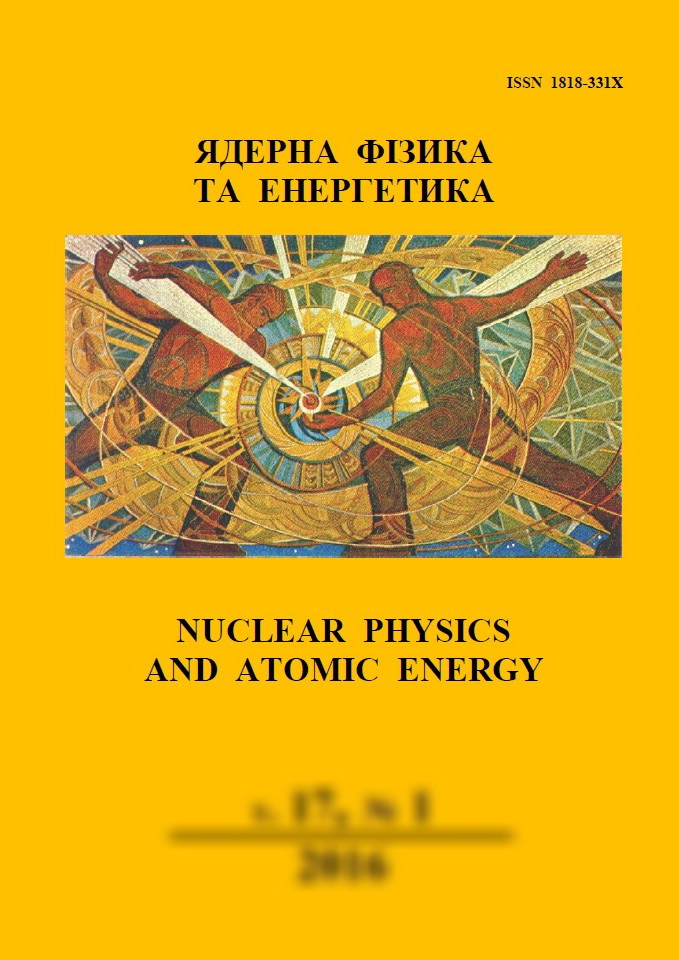 |
Ядерна фізика та енергетика
Nuclear Physics and Atomic Energy
ISSN:
1818-331X (Print), 2074-0565 (Online)
Publisher:
Institute for Nuclear Research of the National Academy of Sciences of Ukraine
Languages:
Ukrainian, English
Periodicity:
4 times per year
Open access peer reviewed journal
|
Nucl. Phys. At. Energy 2014, volume 15, issue 2, pages 154-162.
Section: Radiobiology and Radioecology.
Received: 24.02.2014; Published online: 30.06.2014.
 Full text (en)
Full text (en)
https://doi.org/10.15407/jnpae2014.02.154
Formation of nuclear security culture in Ukraine
S. V. Khyzhnyak1, O. O. Kysil2, V. V. Zhirnov3, O. A. Laposha1, V. S. Morozova1, V. M. Voitsitskiy1
1National University of Life and Environmental Sciences of Ukraine, Kyiv, Ukraine
2Taras Shevchenko National University of Kyiv, Kyiv, Ukraine
3Institute of Bioorganic Chemistry & Petrochemistry, National Academy of Sciences of Ukraine, Kyiv, Ukraine
Abstract:
The radiation-induced effects at dose rate of 0.35 Gy/min (in vivo) and of ultra-low doses (in vitro) on
the cell membranes structural state were shown. The modifications of the membrane protein and lipid
components and their dynamic state were revealed at experimental irradiation conditions by fluorescent
probe analysis. The principal component analysis of the research data indicates the dose-dependent decrease
of plasma membrane structural orderliness of the small intestine enterocytes with the increase of the ionizing
irradiation acute dose of 0.5, 1.0, 2.0, 3.0 Gy at dose rate of 0.35 Gy/min. The complex response of the
biological structure - the erythrocytes plasma membrane, on the ionizing radiation action at ultra-low doses
that occurred through macromolecular structural rearrangements was also demonstrated. The features of the
structural rearrangement of the cellular membranes depending on the ionizing radiation dose (dose rate) are
found out.
Keywords:
ionizing irradiation, dose rate, ultra-low doses, factor statistical analysis, cell membranes,
structure.
References:
1. Eidus L. Kh. Membrane Mechanism of Biological
Influence of Low Doses (M.: Inst. Theor. & Exp.
Physics Publishers, 2001) 81 p.
2. Burlakova E. B. New aspects of regularities in the action of low doses of low level irradiation. In Low Doses of Radiation - Are They Dangerous? Ed. E. B. Burlakova. (N.Y.: Nova Science Publishers, Inc. Hungtington,
2000) Ch. 1.
3. Baverstok K. Radiation-induced genomic instability: a paradigm-breaking phenomenon and its relevance to
environmentally induced cancer. Mutat. Res. 454 (2000) 89.
https://doi.org/10.1016/S0027-5107(00)00100-7
4. Eidus L. Kh. About the induction mechanism of DNA
destruction reparation at the ionizing radiation
influence on the cells. Radiation Biology and
Ecology 40 (2000) 674.
5. Kudryashov Yu. B. Main principles in radiobiology.
Radiation Biology and Ecology 41 (2001) 531.
6. Kudryashov Yu. B. Radiation Biophysics (Ionizing
Radiation) (M.: Phys. Mat. Lit., 2004) 448 p.
7. Кutlakhmedov Yu. O., Voitsitsky V. M., Khyzhnyak S. V.
Radiation Biology (K.: Kyiv University, 2011) 543 p.
8. Benderitter M., Vincent-Genod L., Berroud A. et al.
Radio-induced structural membrane modifications: a
potential bioindicator of ionizing radiation exprosure? Int. J. Radiat. Biol. 75 (1999) 1043.
https://doi.org/10.1080/095530099139818
9. Choudhary D., Srivastava M., Sarma A., Kale R. K.
Effect of high linear energy transfer radiation on
biological membranes. Radiat. Environ. Biophys. 73 (1998) 177.
https://doi.org/10.1007/s004110050114
10. Khyzhnyak S. V., Voitsitsky V. M. Radiation-induced
Structural Metabolic Modification of Enterocytes and
Lymphoid Tissue. (Ed. by M. E. Kucherenko, K.: Phytosociocenter, 2006) 245 p.
11. Schmidt-Ullrich R. K., Dent P., Gramt S. et al. Signal Transduction and Cellular Radiation Responses. Radiat.
Res. 153 (2000) 245.
https://doi.org/10.1667/0033-7587(2000)153[0245:STACRR]2.0.CO;2
12. Gennis R. B. Biomembranes. Molecular Structure and Function (M.: Mir, 1997) 624 p.
13. Ryskulova S. T. Radiation Biology of Plasmatic
Membranes (M.: Energoatomizdat, 1986) 126 p.
14. Kycherenko M. E., Khyzhnyak S. V., Vekslyarsky R. Z.,
Voitsitsky V. M. Small Intestine Enterocytes and Radiation (K: Phytosociocenter, 2003) 176 p.
15. Khyzhnyak S. V. Radiosensitivity of the Small Intestine Epithelium Cells (K.: Kyiv University, 1997) 148 p.
16. Khyzhnyak S. V. The Comparative Study of Physical Properties of Apical and Basolateral Membranes of Small Intestine Enterocytes Affected by Ionizing Radiation. Ukr. Biochem. J. 70 (1998) 44.
17. Khyzhnyak S. V., Kysil O. O., Laposha E. A. et al. Effect of chronic ionizing irradiation on the structural properties of the apical and mitochondrial membranes of small intestine enterocytes. Radiation
Biology. Radioecology 46 (2006) 27.
18. Kysil O., Khyzhnyak V., Klepko A., Voitsitskiy V. The
structural and functional state of enterocyte
mitochondria under chronic and single ionizing
irradiation. In book: Current Problems of Radiation
Research (K.: Ukraine NSA, 2007) p. 134.
19. Dobrecov G. E. Using of Fluorescence Probes in Cell,
Membrane and Lipoprotein Study (M.: Nauka, 1989) 277 p.
20. Vladimirov Yu. A., Dobrecov G. E. Using of Fluorescence Probes in Biological Membrane Study (M.: Nauka, 1980) 320 p.
21. Dergunov A. D., Kaprelyanc A. S., Kabishev A. A. et al.
The existence of boundary lipids in the reconstructed hydrophobic protein-lipid system. Biochemistry 47 (1982) 296.
22. Voitsitskiy V. M., Khyzhnyak S. V., Zhirnov V. V.,
Laposha O. A. The structural organization of
erythrocyte membranes at the action of ionizing
radiation at low doses. Physics of Alive 16 (2008) 58.
23. Zhirnov V., Khyzhnyak S., Voitsitskiy V. The effects of
ultra-low dose β-radiation on the physical properties of
human erythrocyte membranes. Int. J. of Radiation
Biology 86 (2010) 499.
https://doi.org/10.3109/09553001003717167
24. Loevinger R., Budinger T. F., Watson E. E. MIRD
Primer for Absorbed Dose Calculations (New York:
Society of Nuclear Medicine, 1991) 41 р.
25. Demchenko A. P. Luminescence and Dynamics of
Protein Structure (K.: Naukova Dumka, 1988) 280 p.
26. Lactovich J. Principles of Fluorescence Spectroscopy (M.: Mir, 1986) 321 р.
27. Ehutkyn G., Jakubowski S., Hatsko G. G. The physicochemical status of the plasma membranes of rat fatty tissue and liver in the late periods after gamma irradiation at a dose of 1 Gy. Radiation Biology. Radioecology 33 (1993) 61.
28. Iberla K. Principal Component Analysis (M.: Mir,
1972) 316 p.
29. Kramer G. Mathematical Methods of Statistics (M: Mir, 1975) 648 p.
